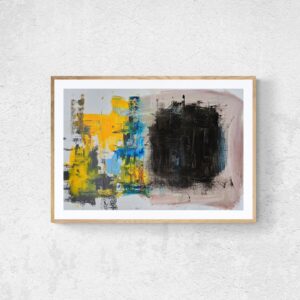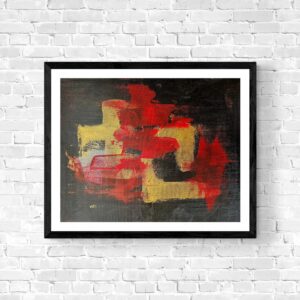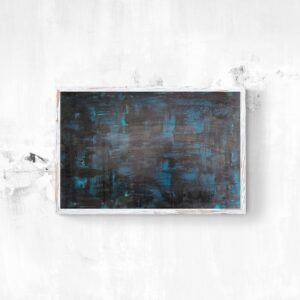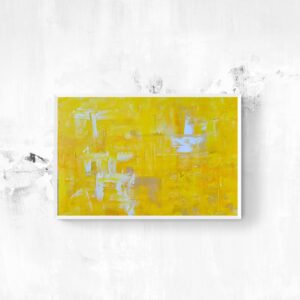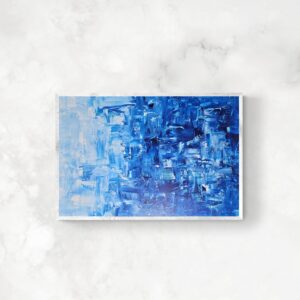
“Nobody knew what was in my mind anyway, least of all myself,” late artist June Leaf said in a 2010 interview about her creative awakening as a child in Chicago. “So little did [my mother] realize that what was being developed in her house was a volcano.” No wonder that, in many of the artist’s drawings, figures and rooms seem to explode, a messy residue bursting from within. Throughout her life, Leaf vividly recalled her burgeoning artistic self-awareness, which came in sometimes “ecstatic” bursts, and saw her artistic career within the trajectory of those bursts.
It makes sense, therefore, that Shooting from the Heart, a retrospective of Leaf, who died a little over a year ago at 94, arranges a generous 120 works thematically, rather than chronologically. The exhibition was co-organized by the Addison Gallery of American Art at Phillips Academy in Andover, Massachusetts, where the exhibition debuted, and the Allen Memorial Art Gallery at Oberlin College in Oberlin, Ohio, where it will travel next — both institutions with longstanding relationships to Leaf’s work. It’s currently on view at the Grey Art Gallery in New York, in the Lower East Side neighborhood, where she resided off and on for many years. As a whole, it captures Leaf’s restless experimentation across media and the unceasing movement and performance-like nature of her works, including a carnivalesque playfulness. Yet it misses something of the cluttered chaos of her working process — also the most fitting environment to discover her works.

Leaf had an avid following, and though her work was not neglected during her lifetime — the Whitney Museum of American Art held an exhibition in 2016 — she is oddly underknown, perhaps due to the fact that she stood geographically and artistically outside the mainstream, even as she maintained close ties with other artists. From the 1970s onward, Leaf spent a good deal of time in Mabou, Cape Breton Island, Nova Scotia, a remote and wild location that gave her the quiet and space to fuel her restless experimentation with all manner of modes and materials. She began as a painter, but soon began incorporating and tweaking found objects into works that were sometimes literally kinetic but which always suggested movement.
Her work was consistently figurative, spurred early on by a loose association with artists like Leon Golub and the Chicago Monster Roster, and inspiration from Paul Klee and Jean Dubuffet. She studied and taught at the New Bauhaus in Chicago and was never inclined to view art as the pursuit of purity of form or practice. She can sometimes verge on abstraction, especially in her marvelous drawings, which often involve blurred and splotchy surfaces. And she was always looking at the world and its follies, as evidenced in a series of hilarious glasses that look like inverted lenses from a microscope, another favorite tool — see, for instance, “Glasses” (2003), which is included in the Grey Art Museum presentation.
Leaf studied dance as a teenager, and as her friend Joan Jonas (another denizen of Nova Scotia) notes in a foreword in the show’s catalog, there was always something of performance in the way she moved and made. However you view Leaf, you yourself are also propelled through space and time, vaulting through a range of scales, finding recurrent characters both large and small, and feeling at the end as though you have experienced a life as well as a body of work. This exhibition captures that spirit most fully in a section entitled “To Create Life Out of Life,” drawn from the name of a drawing, in which her figures climb, fly, and find their balance. Sometimes they do so alone, as in the funky 3D painting “Tight Rope Walker” (1968) included in her breakout show at Allan Frumkin Gallery that same year, and sometimes with a partner, as in “Man and Woman Hunting on the Ice” (1976), in which a tin woman seems to push a tin man off the edge of a rod — a playfully provocative view of sexual politics that also cuts a throughline through her oeuvre.

In her carnivalesque play — recurring motifs include arcades, miniature theaters, and hobby horses — Leaf is the heir of artists such as Alexander Calder, though she embeds her figures, especially women, in what sometimes feel like threatening, psychically charged situations. In one group of works from around 1980, a woman’s head balloons backward, as if ready to pop. The catalog tells us that Leaf often sat at her mother’s feet as the latter operated a treadle sewing machine; one is reminded of the uncanny sculptures of Louise Bourgeois, often inspired by her relationship with a mother who weaved. Indeed, the 1978 sculpture “Woman Theater,” in which an oil-on-canvas woman operates a puppet theater embedded in her midsection, is reminiscent of Bourgeois’s Femme Maison (Woman House) motif from the 1940s.
Indeed, Leaf collected treadles to incorporate into her work. Among the most wonderful of these is “Untitled (Theater)” (2011), in which two small figures stand in a large freestanding shadow box that conjures the dreamlike settings of an empty hall or the inside of a covered wagon. You can almost feel the winds of memory echoing within. Such works are personal and interactive — it made me wish the show included options to operate the little machines or to experience them in the context of a world as chaotic as her studios, surely the most ideal way to discover them. Alas, a retrospective tends to tidy things up a bit too much, though upcoming public programs will presumably involve activation of selected works. (That was how Pirelli HangarBicocca in Milan handled a Tinguely exhibition last year.) No matter: These are works designed, at the very least, to spur a kinetic response inside the viewer’s head — that outside-in and inside-out relationship that was key to her life’s work.



June Leaf: Shooting from the Heart continues at the Grey Art Museum at New York University (18 Cooper Square, East Village, Manhattan) through December 13. The exhibition was co-organized by the Addison Gallery of American Art at Phillips Academy in Andover, Massachusetts, and the Allen Memorial Art Museum at Oberlin College in Oberlin, Ohio. The exhibition was curated by Allison Kemmerer, Gordon Wilkins, and Sam Adams.

